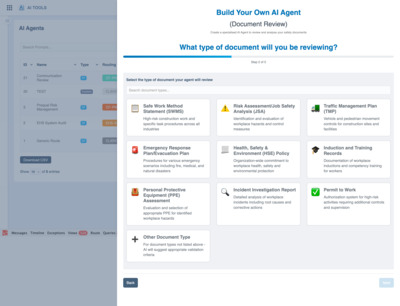AI-Powered Document Management: Streamlining WHS Compliance Workflows

How Intelligent Automation Supports Safety Teams with Routine Administrative Tasks
As many readers would know, workplace health and safety management generates substantial documentation. Risk assessments, safe work method statements, contractor qualifications, insurance certificates, and incident reports all require review, verification, and proper management.
While this documentation serves essential purposes, demonstrating due diligence, ensuring regulatory compliance, and maintaining an audit trail, the administrative burden can consume significant time for a safety manager.
AI-powered automation is now addressing this challenge by handling routine document processing tasks, allowing safety professionals to focus more attention on strategic safety initiatives and frontline engagement.
Understanding the Documentation Workload
Safety teams manage steady volumes of compliance documentation. A medium-sized construction project typically processes 200+ Safe Work Method Statements annually, alongside contractor prequalifications, permit-to-work documents, insurance renewals, certification verifications, and various other compliance records.
Each document requires attention. An inadequate SWMS approval could contribute to incidents; unnecessary delays in processing compliant documentation slow productive work. Traditional approaches, hiring additional coordinators or accepting longer approval timeframes, have limitations as documentation volumes grow with business expansion, contractor engagement, and regulatory requirements.
What AI Automation Handles
Modern AI-powered safety management platforms can process specific types of compliance documentation:
- Document review: Systems can assess whether SWMS adequately identify hazards for described work activities and check for common gaps in risk assessments
- Certification verification: Cross-referencing worker qualifications against assigned tasks, identifying expiring certifications
-
Insurance validation: Extracting key information from certificates, verifying coverage levels, and updating compliance records
These capabilities provide initial document screening, flagging items requiring human review while automatically processing straightforward submissions. Instead of spending 20 minutes reviewing a routine SWMS, safety managers can allocate that time to complex, high-risk scenarios that require expert judgment.
Consistency in Document Review
Manual document review introduces natural variability. Different reviewers interpret requirements differently; the same person may apply varying standards depending on workload, fatigue, or familiarity with particular contractors.
AI systems apply consistent review criteria across all documents. This consistency strengthens audit trails and provides clearer evidence of systematic due diligence processes.
Integration with Operational Systems
Document verification becomes most valuable when integrated with operational workflows. Platforms like ComplyFlow connect document processing with site access management, creating streamlined compliance-to-operations workflows.
For contractor onboarding: submitted qualifications, insurance, and induction records are validated, issues are flagged, and once compliant, site access credentials are provisioned. Non-compliant contractors cannot access sites until the issues are resolved.
For ongoing compliance: when worker certifications expire, site access is suspended until renewal documentation is verified.
ComplyFlow’s Build Your Own Agent functionality allows safety teams to design custom document review workflows adapted to specific compliance requirements without coding.
Strategic Benefits Beyond Time Savings
Automating routine document processing provides safety managers with time to devote to proactive initiatives (for example, analysing incident trends and near-miss patterns, or developing targeted training programs).
AI systems can also identify patterns across large document volumes or data: work activities that consistently result in incidents, contractors with higher non-compliance rates, and sites with recurring documentation issues. These insights support continuous improvement.
For organisations without extensive WHS resources, AI workflows can embed systematic review processes into compliance operations.
Implementation Approach
Successful implementations typically start with high-volume, straightforward processes: document data extraction, expiry tracking, and insurance verification. These prove value while building team confidence before expanding to more complex workflows.
Modern platforms allow customisation around existing processes rather than requiring wholesale operational changes. When safety teams see AI as a productivity tool rather than a replacement, adoption proceeds more smoothly.
Starting points for evaluation: calculate current time spent on routine document review, then explore how automation could redirect that capacity toward strategic safety activities. Many platforms offer demonstrations using actual compliance workflows to show potential time savings.
Market Context
Streamlined compliance processes are increasingly becoming standard expectations. Contractors prefer clients with efficient onboarding. Project timelines assume rapid compliance turnaround. Tender evaluations consider compliance management capabilities.
Organisations relying solely on manual document processing face growing efficiency gaps compared to those using automated workflows.
Conclusion
AI automation for WHS compliance document management offers practical solutions to administrative workload challenges. The technology provides proven capabilities for routine document processing, consistent verification, and integrated operational workflows.
For safety professionals evaluating options, the consideration is whether automated document workflows could free capacity for higher-value safety activities: site engagement, strategic planning, continuous improvement initiatives, and the core work of keeping people safe.
About ComplyFlow
ComplyFlow is an Australian SaaS platform specialising in contractor management, WHS compliance, and AI-powered safety automation. The platform helps organisations streamline compliance workflows, automate document reviews, and maintain real-time visibility across contractor networks.
Create a Free Account: app.complyflow.com.au
Book a demo: www.complyflow.com/contact
Enhance Workplace Safety and Security with Comprehensive Identification Solutions
In an increasingly regulated and security-conscious world, maintaining effective safety protocols...
Workplace Health & Safety Show returns to Sydney
Workplace Health & Safety Show returns to Sydney Showgrounds on 23–24 October 2024,...
ISO Management systems and certifications with Quentic
Your guide to conformity and certification processes with the market-leading software solution.









